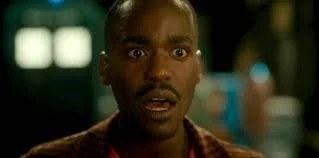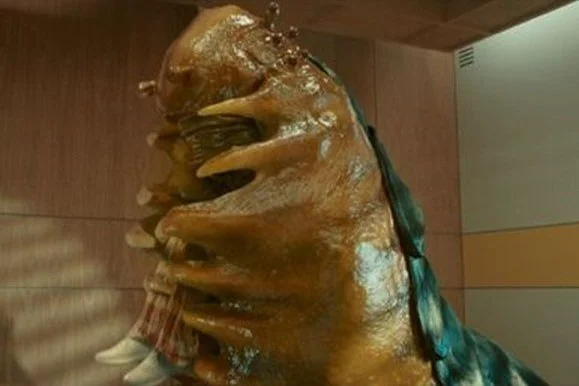“I was so right to hate you” – an analysis of Doctor Who 1.5 ‘Dot and Bubble’
By Elliot Perlic
4/6/24 (all images the right of the BBC)
Doctor Who Season 1 has seen the grand return of Russell T. Davies – so far writing 4 out of 5 of episodes. ‘Space Babies’ was divisive, ‘The Devil’s Chord’ was, in my opinion, an underrated bit of fun; ‘73 Yards’ was an enthralling mystery, and now ‘Dot and Bubble’ becomes the latest instalment in a series of satire, political commentary, and unforeseen gems.
‘Dot and Bubble’ follows Lindy Pepper-Bean, one of thousands of citizens of Finetime glued to her Bubble: a futuristic technology that blends all the amazing and awful parts of Instagram, Facebook, TikTok, Snapchat, WhatsApp, Youtube, Pinterest, and somehow also Google Maps. The young people of Finetime (they are all aged 17-27 and are the children of the Homeworld’s wealthiest inhabitants) can speak whenever they want, share their experiences in real-time, watch the attractive Ricky September every day, and find their way around town to anywhere they want. The downside – the residents of Finetime never turn their Bubbles off and seem entirely helpless without it (Lindy initially can’t even walk with it off as she has no spatial awareness without it on, it’s not that she can’t walk properly as many people joke). As the plot progresses, it is revealed that there are mysterious slug-like creatures eating the residents of Finetime, so the Doctor and companion Ruby Sunday hack into the Bubble to warn everyone and get them out safely. It transpires that in fact the Dot system (which allows everyone to access the Bubble in the first place) has turned sentient and has come to hate its creator after listening to the residents of Finetime “chattering away” (as the Doctor says) and decided to eliminate the entire population both in Finetime and the Homeworld. The Doctor offers to take the survivors in the TARDIS to find a new home, but they opt to brave the outside world and live as pioneers in the wild woods outside the city.
Personally, I can see ‘Dot and Bubble’ becoming a classic Doctor Who episode, a satire in the same vein as Classic Who’s Season 25 story ‘The Happiness Patrol’ and Modern Who’s ‘The Long Game’ and ‘Bad Wolf’ which all see the Doctor and companion(s) step into a regime which on the surface appears to benefit the citizens but as the story progresses reveals that not everything is as rosy as it seems. Lindy’s life appears too polished and perfect: all her clothes are ethically sourced, all her friends love her unreservedly, she only has to work 2 hours a day, and she doesn’t even need to pee every day! Because of this, many people will come to see ‘Dot and Bubble’ as a commentary on Gen-Z’s obsession with social media and the supposed perfection of influencers’ lives (I did on my first watch), a commentary on how staying within your bubble can blind you to the horrors of the world and encourage apathy towards those who are suffering. This all culminates in the death of Ricky September (nee Coombes), where Lindy betrays him to save her own life and afterwards is able to so comfortably lie to the Doctor and Ruby with a smile on her face that Ricky “had other people to save” and was “soooooo brave” – her fake social media persona shining through, her eyes void of any emotion (it is worth saying at this point that Callie Cooke who played Lindy was exceptional throughout the episode presenting a thoroughly unlikable character as hilariously useless and cringe-inducing).
While the episode’s critiques of social media, algorithms, and online vs real life personalities, are absolutely valid, there is another story lying deeper within the episode that many people have not recognised, only noticing the overt comments at the end of the story. I, myself, did not even notice this until my second viewing, but ‘Dot and Bubble’ serves as perhaps one of our time’s greatest commentaries on social bubbles and monoculturalism from a racial lens.
It is so subtle at first – Lindy sees Ncuti Gatwa’s Doctor pop up on her screen and immediately blocks him. You start to notice something is more than meets the eye when Ruby appears, Lindy is taken aback and hesitant but will at least hear her out. Throughout the episode, Lindy consistently blames the Doctor, saying that he has “lied” to her, that everything’s “[his] fault” (as though he created the episode’s slug monsters), and when he pops back up after being blocked she does not recognise him as the same man only someone who she “thought just looked the same” as the black man wearing exactly the same outfit she had seen just hours before. This all culminates at the end of the episode when The Doctor offers to find the survivors of Finetime a new home – only to have his offer declined and when Ruby asks why Lindy singles out the Doctor specifically saying, “because you, sir, are not one of us.” It is at this point that The Doctor is accused of “voodoo” because the TARDIS is bigger on the inside, Lindy’s friend says it is their “God-given duty to maintain the standards of Finetime,”and Lindy is warned to walk away before she is “contaminated”.
“Because you, sir, are not one of us. I mean, you were kind, although it was your duty to
save me, obviously. I mean screen-to-screen contact is just about acceptable but… in person…
that’s impossible.” – Lindy Pepper-Bean (‘Dot and Bubble’)
The Doctor, being The Doctor, offers them another chance to avoid death in the outside world, where the survivors are determined to be “pioneers like [their] ancestors,” foolishly believing it will be an easy journey and they can simply “tame” the planet. The Doctor, being The Doctor, gives them one last chance and cannot even condemn them, only screaming in disbelief before returning to the TARDIS.
This is where ‘Dot and Bubble’ truly shines, and what will make it go down in history as a great Doctor Who story. This is not Season 10s ‘Smile’ where we saw how a modern idea (emojis) would be relevant in the future, no, the ending of the episode turned it into a biting commentary on monoculturalism and insular communities and how – ultimately – they will destroy themselves.
In the 21st century, everyone can feel so divided. Despite billions of people having access to more technology than ever before and being able to access information all over the at the push of a few buttons, the world is divided. Inequalities around wealth, gender, pay, human rights, social class plague modern media – everything is a battle ground for people to score political points and prove their way of life is better. Many people look to blame Gen-Z, a generation of chronically online young people more bothered about creating new words for genders than living in and contributing to the real world. Writer Russell T. Davies shows that there is a section of people online who do that, but it is not the left-leaning members of Gen-Z who are trying to reach out, provide safe spaces, and make people feel accepted. It is, instead, the far-right, traditional, opinionated people stuck in their ways (their bubble) who are causing all the division and unrest. They will accuse people of being “woke” and say that what Gen-Z are asking for is impossible, while themselves being the only barrier to change. On the surface, these people appear harmless, only fighting for traditional values, to uphold the status quo – but underneath there is a sinister agenda where “status quo” does not just mean pushing back against those demanding change but actively destroying those who stand out as different.





